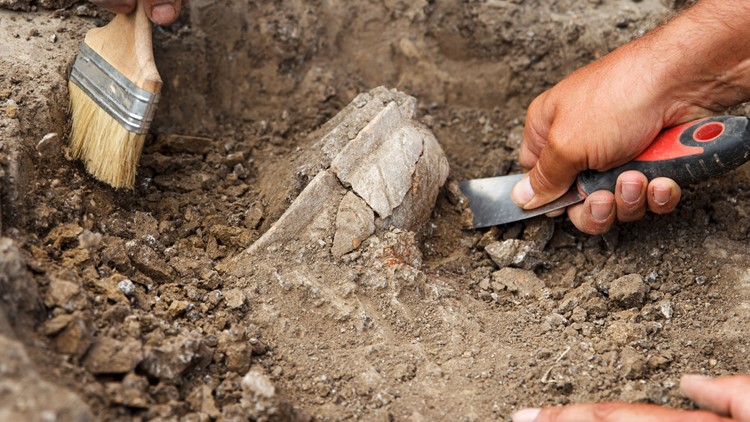JACKSONVILLE, Fla. — Victoria Hayes and Kaia Lacey found buried treasure Wednesday morning as they used spoons to gently scrape the side of a small hole at an archaeological dig on Big Talbot Island.
Pirate gold was not the bounty unearthed by these University of North Florida archaeology students, but a curved piece of glazed pottery that offers more important clues to a Native American village dating back four centuries among these trees.
“Oh, it’s beautiful,” one student said as it was passed around, sand still stuck to it.
The piece of majolica pottery, one side glazed blue and white, is Spanish and not Native American. Its discovery in this dig site means it may have been given or traded to a member of the Mocama tribe who flourished in this area from the 1400s to early 1600s. Even more important, it was unearthed in what appears to be a 50- to 60-foot-diameter community council house in what is believed to be the Mocama village of Sarabay.
If it is a council house, it was the center of life for a significant village of about 100 people, UNF Archaeology Lab Director Keith Ashley said.
“It’s really important,” Ashley said. “There has not been any council house or any large structure like this found in North Florida. ...We would have the first Timucuan council house if this is what it turns out to be, and it lets us know what it is like right here in the center of the community and the artifacts associated with council meetings.”
Mocama Archaeological Project
The dig is part of the UNF Archaeology Lab’s ongoing Mocama Archaeological Project that focuses on the Timucua-speaking people who lived along the Atlantic coast of Northern Florida. The site is deep in the woods at Big Talbot Island State Park in Duval County’s far north coastline, access only via a winding path through palmettos.
These days only a few homes nearby indicate civilization on this wooded spit of land between the Mud River and Simpson Creek.
But in the late 1500s and early 1600s, French and Spanish settlers moving into Northeast Florida met members of the Mocama. That Timucua-speaking Native American chiefdom had prospered for centuries in an estimated 19,000-square-mile area, including what is now Big Talbot Island.
Mocama translates to “sea,” researchers said. But not much else was known about the Mocama chiefdom until Ashley decided to more extensively excavate the area after 1998/1999 “shovel tests” — small digs every 25 yards on the island ’s south end — revealed promising artifacts.
Some dated back a thousand years from one area, but other artifacts dated to the 1500s and 1600s in another, he said.
“We probably had a large community on the island 1,000 years ago, and it breaks up around 1250,” Ashley said as he walked the path. “What you had was people moving around for the next couple hundred years on the island and mainland. Then around 1450 they start to settle down again. That’s the community we are in now.”
Early French accounts in the late 1500s said the dominant chief in the Jacksonville area was Saturiwa, whose village may have been in the Mayport area. There is mention of the village of Sarabay on an island north of the St. Johns River from a Spanish priest living in San Juan del Puerto on Fort George Island in 1602. And a sea captain in 1609 mentions the islands of San Juan (Fort George Island), Santa Maria (Amelia Island) and Sarabay.
“So everything leads us to believe that Sarabay is Big Talbot Island, and we think the community of Sarabay is also on Big Talbot Island,” Ashley said.
It was “an accident, just luck” that enlarging one of the 1998/1999 test sites uncovered evidence of a wall trench where a home once was, Ashley said. It was a “really unique” find, he said, as he stood inside the presumed council house perimeter.
“It was right over there, about 20 meters from where we are now,” Ashley said. ”... We found all this great stuff: a Spanish scabbard tip made from brass; we had some Spanish pottery. But we still had a lot of Native American things and we thought this is a great area.”
Work resumed there, expanding the earlier site to see if it could have been a Timucua village. And in 2020, UNF students led by Ashley and a state permit to excavate “got lucky,” he said.
Deep down in the lighter sand of hundreds of years ago were dark patches. These could be the remains of 11 wooden posts that supported what is believed to be the 16th-century council house, the center of the village, he said.
“We started expanding it and following it,” he said, pointing to the arc of stakes marking those poles in a clearing surrounded by oak, palmetto and cypress on Wednesday.
“We saw a curve, a really distinctive curve and it’s just a much larger diameter than we were expecting,” he added. “We thought we had maybe a regular house, but it just started getting bigger and bigger, Projecting out now, and it’s maybe a bit early, maybe 50 or 60 feet in diameter.”
No sweat for these university students
About 20 students have been methodically working in four precisely dug trenches in the clearing. They carefully scrape sand away, sieving it to find pottery pieces, fine brush strokes revealing intricate swirl designs 400 years old.
Annie Bitner, there on an undergraduate grant, said the discovery of a council house can reveal so much. So does the discovery of unglazed indigenous pottery called colonoware in one corner of the council house site. That’s significant, indicating this village interacted with European settlers, she said.
“Finding a council house can tell us about population size here at the village and can also determine where other houses are here,” she said. ”... Colonoware is indigenous-made pottery, influenced by what European vessels looked like, so they started making pitchers and stuff instead of just bowls.”
Senior Magdalynne Alley is glad UNF has a hands-on archaeology program that focuses on the local Timucua as she spent part of Wednesday in a trench on the south end of the dig. While the COVID-19 pandemic limited many archaeological digs elsewhere, UNF’s continued and uncovered this important find, she said.
“We still get to do our field schools, continue as normal and we get to learn about the indigenous history in Jacksonville, which I think is really cool,” she said. ”... Dr. Ashley has been working on this for decades and I am glad we finally got to uncover stuff that he’s been working so hard on.”
The site has revealed bone and shell tools, plus pieces of Spanish olive jar. An estimated 10,000 small and big pieces of indigenous pottery have been found, some carbon-dated to around 1580 to 1620. Some can be traced to St. Augustine chiefdoms, indicating trade among those who lived here centuries ago, Bitner said.
“We know there is a broader chain of communication, trading and networking happening among them across Florida and the country,” she said. “I am sweating out here, but I love it!”
Uncovered on Wednesday were two tiny jaw pieces complete with teeth, maybe the remains of a 16th-century meal. Other students are working in a central site where the main fire may have been, with some evidence of charcoal found.
“It’s really way too early to say if that’s the central fire,” Ashley cautioned.
Ashley doesn’t know if people just left the village in the early 1600s, the last time anyone mentions Sarabay, or just moved to other villages. But while the excavation wraps up this month, Ashley and students hope to return to find the rest of the council house and possibly “everyday households” that surrounded it.



